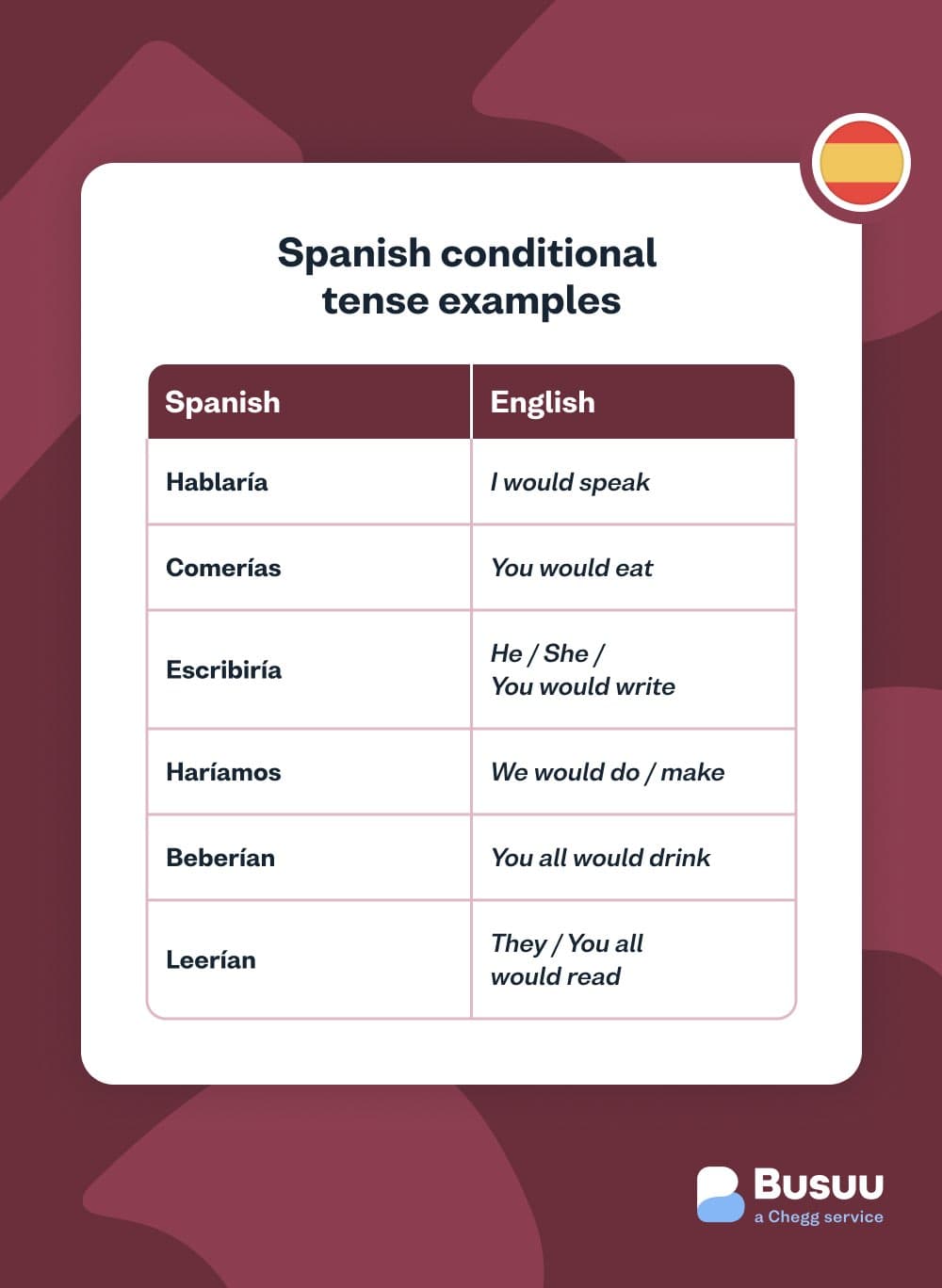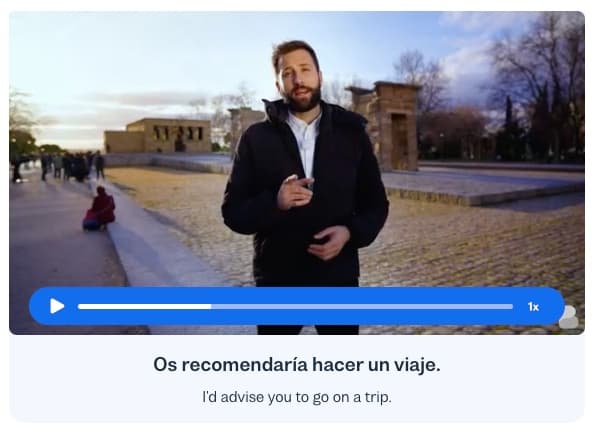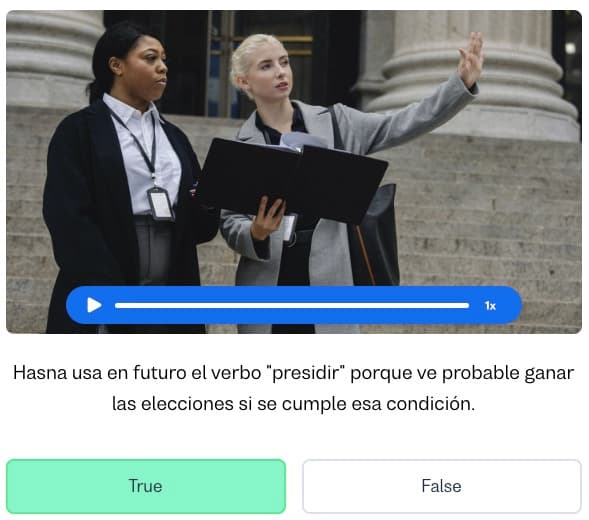I want to learn...
As we dive deeper into the intricacies of the Spanish language, one aspect that allows us to express hypothetical situations, desires, and probabilities is conditional mode.
By mastering conditional tense, you can add nuance and sophistication to your conversations and written expressions. In this article, we will explore the formation and usage of the conditional mode in Spanish, thus empowering you to wield its power effectively.
How to form a conditional tense
To form the conditional tense in Spanish, you need to use the infinitive form of the verb and add the corresponding endings for each subject pronoun. Regardless of the verb type(-ar, -er, or -ir), the endings remain the same.
In singular-plural order, 1st-3rd, the terminations are:-ía, -ías, -ía, -íamos, -ían, -ían.
For example:
Hablaría (I would speak)
Comerías (You would eat)
Escribiría (He/She/You would write)
Haríamos (We would do/make)
Beberían (You all would drink)
Leerían (They/You all would read)

The only exception to this rule would be irregular verbs. The stems are not the same, and sometimes, the verb has a completely irregular form which must be memorized.
For example:
Ser (to be) - sería (I would be).
Tener (to have) - tendría (I would have).
Poder (to be able to) - podría (I would be able to).
Haber (to have) - habría (I would have).
The differences don’t stop there. But don’t worry about memorizing them all at once. You can understand and learn most of them with practice, these are just some of the most important ones.
When to use the conditional tense
The conditional tense is used for a variety of situations, from creating imaginary scenarios, to making polite requests. Let’s have a look at some situations below.
1. Hypothetical situations
The primary use of the conditional tense is to express hypothetical or unreal situations. It allows us to discuss what would happen under certain circumstances.
It’s usually preceded by a subjunctive verb conjugation, as an “if” before establishing the conditional as the “then” of the sentence.
Here are a few examples:
Si tuviera dinero, viajaría por el mundo. (If I had money, I would travel the world.)
Si estudiara más, sacaría mejores notas. (If I studied more, I would get better grades.)
Si lloviera, no saldríamos de casa. (If it rained, we wouldn't leave the house.)
2. Polite requests
The conditional tense can also be used to make polite requests or offers. It softens the tone and shows respect.
¿Podría pasarme la sal, por favor? (Could you pass me the salt, please?)
¿Me ayudarías con este problema? (Would you help me with this problem?)
¿Estarías interesado en acompañarnos al concierto? (Would you be interested in joining us for the concert?)
3. Expressing the future in the past
That may sound somewhat confusing. However, in reported speech or narration, the conditional tense is used to express future events from a past perspective. It conveys what someone said or thought would happen.
For example:
Dijo que vendría a la fiesta. (He said he would come to the party.)
Pensé que ganaríamos el partido. (I thought we would win the game.)
Creíamos que irían de vacaciones. (We believed they would go on vacation.)
4. Expressions accompanying the conditional tense
There are some common expressions in Spanish that use the conditional tense. These can express wishes, preferences and more. These expressions also add depth and nuance to our conversations.
As a side note, by and large, these terms are used in the first person.
5. Ojalá
This term is used to express someone’s hopes and desires. It is often followed by the conditional tense to indicate something we wish would happen.
Ojalá pudiera viajar por el mundo. (I wish I could travel the world.)
Ojalá tuviéramos más tiempo juntos. (I wish we had more time together.)
6. Gustaría
Gustaríais a polite way to express what we would like or prefer. It is frequently used to be polite when asking someone out, but it could even be used when ordering food. In other cases, it can be used interchangeably withojalá.
Me gustaría tomar un café contigo. (I would like to have a coffee with you.)
¿Te gustaría aprender a tocar la guitarra? (Would you like to learn how to play guitar?)
Me gustaría viajar por el mundo. (I would like to travel the world.)
7. Debería
This expression is used to express what someone should or ought to do. Typically, it is used when giving advice or a suggestion when you don’t want to sound too assertive.
Deberías estudiar para el examen. (You should study for the exam.)
Debería llamar a mis padres. (I should call my parents.)
The conditional mode in Spanish opens the door to a world of possibilities. It allows you to express hypothetical scenarios, desires, probabilities, and more. Although it’s a slightly more advanced topic in Spanish-learning, you could argue it’s one of the most important tenses to learn.
By grasping the formation and usage of the conditional tense, you gain the ability to convey nuanced meanings and to engage in sophisticated conversations.
Remember to practice it in different contexts. Exposure to real-life examples will strengthen your command of this mode.
Newlanguages


